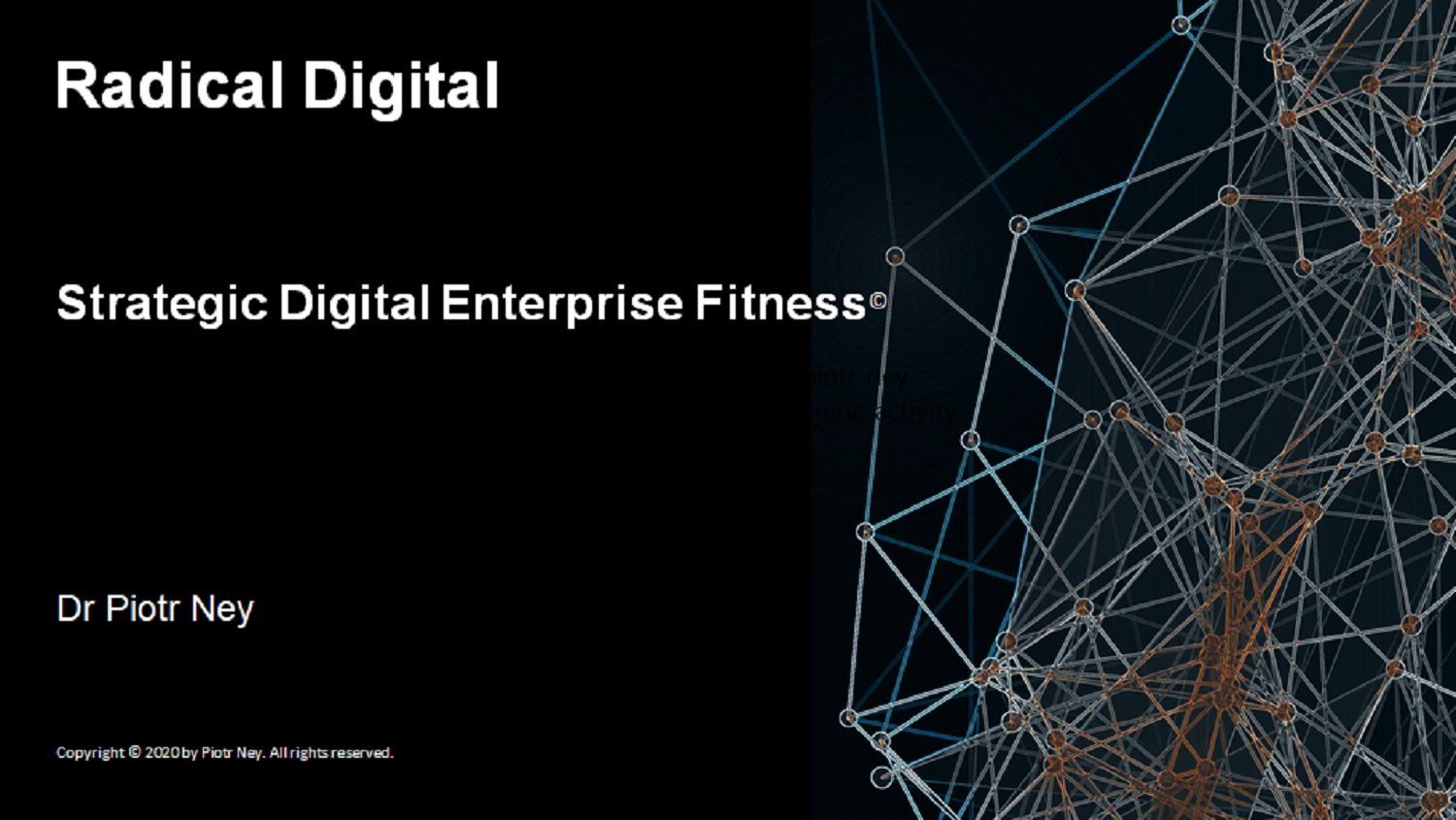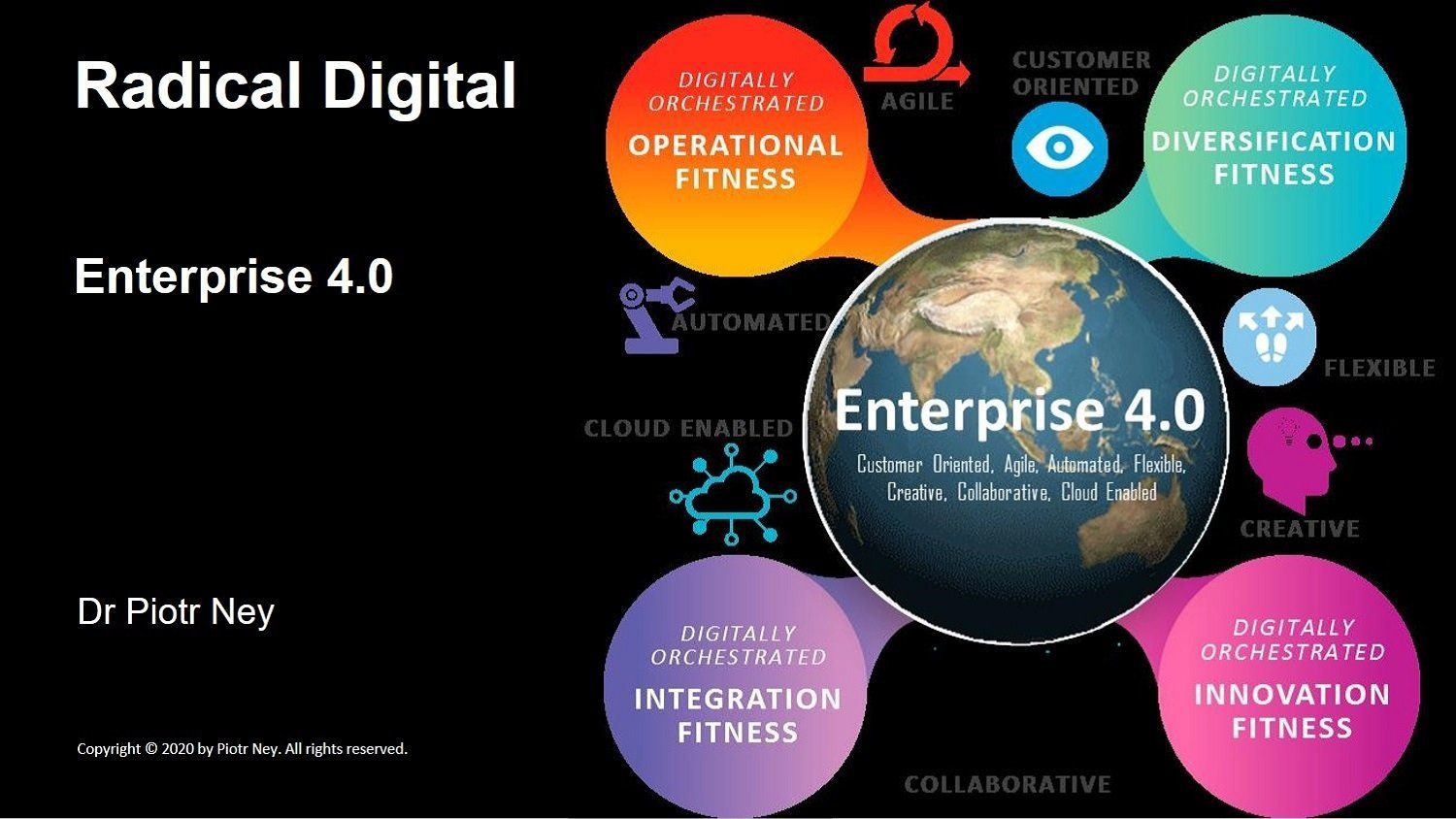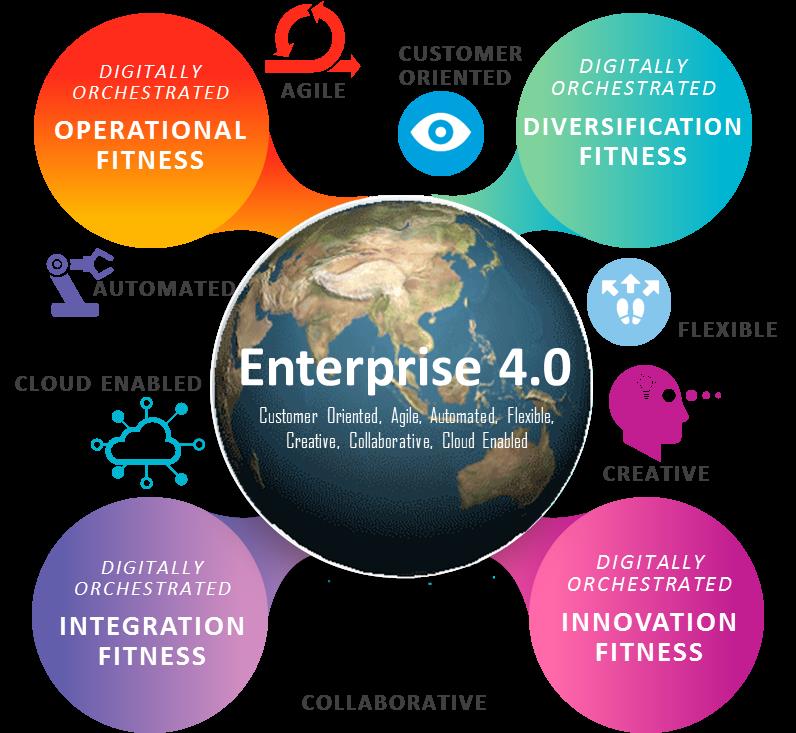Radical Digital: Strategic Digital Enterprise Fitness ©

[London, 23 April 2020]
In Reimagining the enterprise for the digital age, I argue that a tactical use of digital technology, the digitalising of existing business paradigms and business-as-usual (BAU) processes, is unlikely ever to deliver sustainable competitive advantage.
Instead, considering the truly transformative potential of digital, a combination of strategic outside-in and inside-out digital perspectives needs to be applied. An example of the outside-in perspective, which focuses on specific technologies, could be, “how could our logistics change through adopting blockchain?”. The inside-out strategic digital perspective more fundamentally reimagines how, if we were designing our enterprise from scratch, we could harness digital innovation to transform to a truly differentiated business model.
Enterprises still typically approach digital transformation in a very traditional way. First design the digital-first target operating model (TOM) and then the roadmap to deliver it. In this article, I argue that this is no longer adequate. Any target design is likely to be already out-of-date before it is even fully implemented. My Strategic Digital Enterprise Fitness (SDEF) approach is not fixed on delivering a specific, fixed, future-state operating model. This transformational approach looks beyond this, treating corporate renewal as the continuous process of developing the dynamic, agile, digital enterprise capabilities, which make the enterprise fit-for-purpose for our Economy 4.0.
An insight from biology: forget operating models, think operational fitness
In the last article, I encouraged digital innovators to look well beyond the current business paradigm to challenge its axioms and entrenched modi operandi, with questions such as: “how do we rapidly evolve our culture and operations to best deliver our future products to our future customers?”. In this simple question, we actually encapsulate at least five complex dimensions:
- who will become our most valuable customers in the future?
- what will their behaviours and careabouts be?
- what will our products need to become to support these behaviours and satisfy these careabouts?
- what operating model will we need to create and deliver these products?
- what digital and other capabilities do we now need to develop to make this realistic?
It is worth remembering, that future customer behaviours and careabouts could differ significantly from those we recognise today, so our products and capabilities, as well as brand claims such as those around CSR, could equally need to be very different from today's.
I have discussed general insurance as an example of an industry that is likely to be revolutionised by digital. For consistency, allow me to continue with this current “our company, in isolation, sells predefined policies to individual customers” archetype of the insurer.
The simple question above, if pursued with a radical digital mindset, could for example explore the potential metasystem transition of an insurer into a player in (multiple, self-organising) digital ecosystems, where many traditional products (in this case protection) increasingly evolve into hyperpersonalised, context-aware, embedded and ubiquitous features of the ecosystem, and traditional actors increasing evolve into dynamically reconfigurable, multi-role entities. In other words, the concept of general insurance could radically be transformed beyond recognition, into a profoundly new paradigm in the digital world.
So what should the ideal digital target operating model be?
I sometimes pose this question rhetorically in strategy workshops with business leaders to subtly test whether they truly appreciate the transformative promise of digital and to gauge their scale of ambition for disruption. This of course is a trick question.
Adopted as a strategic competence, digital makes much conventional operating model design conceptually redundant, especially in tertiary sector domains like BFSI (the ‘I’ here of course stands for Insurance). Farewell then to rigid functional structures, hierarchical organisations and value chains hard-coded with long-term, inflexible commitments and outdated legal constructs. All of these are rooted in industrial age thinking. Yet future state enterprise visioning exercises by business leaders (often with the help of expensive consultants and conducted in times of commercial duress) persist in churning out PowerPoint decks of phased migration roadmaps from current (rigid) operating models, with their embedded axioms, to new (rigid) versions.
This conventional, approach to future state enterprise design is no longer fit for purpose in the increasingly complex and unpredictable digital economy, driven by rapidly accelerating yet gloriously stochastic innovation processes. Technological and commercial disruption makes those impressive PowerPoint decks fast redundant. The enterprise needs to be redesigned not for the current Five Forces landscape, but its future and yet unfamiliar mutation (future offerings to meet the future needs of future customers), within a future societal and regulatory environment. Future in this context often arrives well before the business completes the planned migration journey.
One reaction is to regularly invite back those expensive consultants to continuously flex the target models and roadmaps. But as this ingrained approach to business strategy (migrating from one steady state to another, usually as a response to stress) mimics the punctuated equilibrium theory of natural evolution, indulge me to refer to some further insights and parallels in evolutionary biology, which suggest a different approach.
Evolution is chaotic and fuelled by complex, multilevel causalities. It is also directionless. Neither is it pushed by some invisible power or intellect (with my apologies to God), nor is it pulled by some desired and pre-defined future end-state. Biologists have long discounted popular ideas of any directional evolutionary impetus, such as the intuitive notion that evolution naturally favours increasing complexity (think, you host trillions of microbes, which outnumber the number of your own, human cells and account for more than half of your body weight!).
Instead of teleologically favouring any specific design or end-state, natural evolution drives preferentially in the direction of increasing fitness. This suggests that for the enterprise to thrive in the digital age, it is its operational fitness, and not any specific operational model, that we should focus on developing.
Two further convincing patterns in evolutionary trajectory are also directly relevant to digital enterprises. I quote;
“Two great trends are evident in the evolution of life on Earth: towards increasing diversification and towards increasing integration. Diversification has spread living processes across the planet, progressively increasing the range of environments and free energy sources exploited by life. Integration has proceeded through a stepwise process in which living entities at one level are integrated into cooperative groups that become larger-scale entities at the next level, and so on, producing cooperative organizations of increasing scale” .
The Strategic Digital Enterprise Fitness (SDEF) philosophy
Inspired by such judicious insights from Mother Nature, allow me now to return to the world of digital and introduce you to the concept of Strategic Digital Enterprise Fitness (SDEF) . This enterprise philosophy does not advocate the waterfall style development of, and then anchoring to, any specific operating model. It focuses on creating and sustainably maintaining dynamic operational fitness using an agile philosophy, by incrementally embedding enhanced digital age characteristics (its new digital DNA) into the operating model and culture.
SDEF drives the process of continuous readjustment
and promotes the view of operationally fit enterprises as deeply digitally enabled, fluid networks of continuously evolving and dynamically reconfigurable capabilities and resources.
Some examples of these digital DNA characteristics include…
• increasing, digitally-orchestrated operational fitness
- nimble in every dimension;
- innovative in every dimension; culture of actively involving everyone in driving enterprise evolution;
- ultralean, networked, distributed and dynamically reconfigurable structure;
- culture of empowerment and autonomy;
- clear focus on the continuous renewal of core competitive competencies;
- insight-driven, digital-first and IoT-enabled processes throughout;
- socially engaged and emotionally convincing to all stakeholders, esp. customers and staff;
• increasing, digitally-orchestrated diversification fitness
- flexible and easily configurable products;
- mobile, modular and portable operating elements and resources;
- open innovation model;
- ability to rapidly develop niche competencies and resources;
- competitive, innovative niche and adjacent markets competencies;
- product strategy oriented to quickly customising core offerings for specific microsegments;
• increasing, digitally-orchestrated integration fitness
- industry-leading, open, digital collaboration platforms;
- collaborative culture (including active co-creation with partners and customers)
- an environment which promotes cooperative and self-organising tribes (e.g. communities of practice), networks and ecosystems;
- advanced AI to effectively manage growing degrees of content complexity, nestedness and overlap;
- visual/virtual network and content navigation;
- ositive focus on diversity, creative abrasion and cross-pollination of ideas.
Strategic Digital Enterprise Fitness: a summary
The strategic digital fitness focus ensures that the enterprise maximises its odds to thrive in an unpredictable and rapidly evolving environment. The sustainable competitive advantage of any digitally fit enterprise, and the consistently supranormal returns this generates, becomes a function of the renewal velocity of its digital capabilities (to keep resource based theorists happy, these ideally need to be demonstrably innovative, imperfectly imitable and non-substitutable) and the managerial competence to dynamically reconfigure and deploy these resources in time and in line with changing business priorities.
To control and prioritise investment in digital, business leaders must never forget that, as with any other resource, its utility always remains directly proportional to its contribution within a strategically agreed domain of action, such as improving customer experience or reducing front-office operational cost. Just because a digital application is cool, it does not necessarily mean it will positively impact your business.
You will have noticed that I have clustered the above examples of digital DNA corporate characteristics to reflect the three evolutionary insights from biology. There are indeed many other analogies between the digital enterprise and natural evolution trajectories. But there is also at least one essential difference. Digital transformation leaders can play God (through vision, guidance, investment, engagement) to give their enterprise evolution a push, set its initial direction (its desired trajectory) and continuously evaluate its progress and the improving fitness of their business. In my professional experience, future success can be delivered successfully without a PowerPoint graphic of the future state at the outset.
I call on business leaders to embrace digital innovation as a radical catalyst to fundamentally transform their operating and market philosophy. The approach to this transformation should look beyond developing a roadmap to some defined future operating model. It needs instead to treat corporate renewal as the continuous process of developing the dynamic, agile, digitally-orchestrated enterprise capabilities, which make the enterprise fit-for-purpose for Economy 4.0.
References:
i. John E. Stewart, “The direction of evolution: The rise of cooperative organization”, Biosystems, 123, pp.27-36, Sept.2014
ii. Strategic Digital Enterprise Fitness (SDEF) is actually a term that I had personally invented some time ago as useful conceptual shorthand when discussing strategy. If you may find it useful yourself, I would be delighted if you adopt it!
iii. You may recognise this as the well-known dynamics capabilities perspective discussed initially by David Teece, Gary Pisano and Amy Shuen (in "Dynamic capabilities and strategic management", Strategic Management Journal, 18 (7), pp. 509–533, 1997) and enhanced by several academics and studies since.
Dr Piotr Ney is an energetic promoter of innovation, digital transformation, customer and operational excellence, and sustainability, with some thirty five years of change leadership, consultancy and senior executive experience. He has an MBA in International Business and a PhD in Economics and Management, lectures part-time in Innovation Management and Disruptive Strategy and is a popular speaker at global business events. Piotr works in London and internationally as an independent consultant and educator.
Copyright © 2020 by Piotr Ney. All rights reserved. No part of this work may be published, reproduced or transmitted in any form or by any means, electronic, mechanical, photocopying, recording, or otherwise, without prior written permission of the author.


